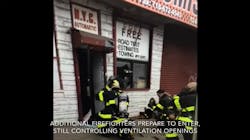Tactics for Elongated Decay and Ventilation-Limited Fires
Five years ago on Easter Sunday, April 1, 2018, I was the incident commander (IC) at an early-morning fire in a commercial auto repair shop in Queens, New York. Following the extinguishment of the fire, I asked some of the bystanders that I saw taking videos if they would mind sharing their videos with me to use during training. Many agreed and I took the videos I obtained and combined them into a single video in chronological order to get a more complete video picture of the incident.
I began using the video for training, primarily on fire dynamics to highlight the successful tactics used that maintained the fire in a ventilation limited stage and led to the quick extinguishment of this fire. Truthfully, if it had not been for the bystander’s willingness to share their videos, this fire would have simply faded into obscurity as another successful outcome by my well-trained FDNY units.
Thankfully, that was not the case and I have been using this video for the past five years. Perhaps surprisingly, this is the first time I am writing about this fire. I am writing about it now – because recently, I posted a link to the video and several points to consider on social media. There were many thoughtful comments, questions and messages received on several key points. Not wanting to miss a training opportunity, this led me to write this more detailed account of the incident.
Nothing showing upon arrival
I was working in Battalion 46, which is in quarters with Engine 287 and Ladder 136, also known as the "Elmhurst Eagles." The reported fire location was on Queens Boulevard, a relatively straight run and quick response with very light Sunday morning traffic. The run came in just before 8:30 a.m., and on arrival, there was nothing showing. A woman who worked at the car wash next door called the fire department and she told me there was a lot of smoke coming from the structure before we arrived.
Rescue 4, along with Ladder 136, began to force entry into the front of the structure. Quickly seeing smoke banked down to the floor and feeling a high heat condition, they relayed to me to transmit the 10-75 signal, indicating a working fire. The two companies began to search for the fire while controlling the air to the fire. The engine companies — Engine 292 and Engine 287 — began to stretch a handline to the front door. Once at the front door with a charged hoseline, and the location of the fire known, they made entry to extinguish the fire.
The building had not been occupied since the day before. And the fire had likely been burning for several hours at the time the fire department was notified. The fire was in a ventilation-limited state, meaning that the fire was now in the decay stage and had used up the available oxygen. Left without oxygen, the fire would continue to smolder and lose energy and pressure. The high heat environment also begun to cool. Oxygen to a fire is like spinach to Popeye. Just like Popeye cannot get stronger without his spinach, the fire cannot get bigger without oxygen. Once a fire uses the available oxygen, it cannot grow unless it gets more oxygen.
The fire was no longer creating pressure and because of this, no smoke was pushing or visible from the structure upon the fire department's arrival. Once we forced entry at the front door and provided a small amount of air (oxygen) to the fire, it began to grow again. However, the firefighters recognized that the fire was ventilation-limited and controlled the openings to the structure.
Early decay stage fires
Modern content fires enter an early decay stage, producing heavy smoke with varying and decreasing heat conditions, due to the limited available oxygen to support flaming combustion. The fire will remain in the decay stage as long as it remains ventilation limited. Firefighters want to extend or elongate this decay stage.
The elongated decay stage is where the fire is kept ventilation limited. It is where firefighters can effectively operate and extinguish the fire by denying the fire additional oxygen, thereby limiting fire growth and smoke production. This elongated decay stage is purposefully maintained by firefighters while coordinating ventilation with the application of water on the fire. It is understood that some fire growth will occur once the fire attack begins with the introduction of oxygen through controlled openings necessary for suppression.
While the small amount of air introduced at the front door would allow the fire to grow, it would not allow the fire to grow out of control and was still ventilation-limited and in an elongated decay stage. However, if additional ventilation opening were made, either by rogue or untrained firefighters or due to windows breaking from the heat, this could have allowed the fire to grow very quickly and overwhelm the firefighters.
This is why the ventilation profile is so important. The ventilation profile is the appearance of the fire building’s ventilation points showing the flow paths of heat and smoke out of the structure as well as any air movement into the structure. It is an evaluation of fire behavior. It is important to understand the potential uncontrolled ventilation points of the structure, including openings that can fail without warning. The ventilation points that the fire department cannot always control such as windows and skylights.
The ventilation profile
At this fire, Exposure 1 (Alpha) was a commercial roll down garage door and a typical entrance door with a very small window next to the door. Exposure 2 (Bravo) did not have any windows, Exposure 3 (Charlie) had a commercial roll down garage door with a typical entrance door. Exposure 4 shared a common wall with the adjoining occupancy. The roof was wood and had a skylight towards the middle of the structure.
Based on the above potential uncontrolled ventilation, the fire department had the ability to fully control most of the ventilation and therefore can fully control most of the air to the fire and keep the fire ventilation limited. Simply stated, a ventilation-limited fire cannot grow larger if it does not have oxygen to do so. It is physics – and physics are the same regardless of where you are a firefighter.
It would take a firefighter action such as opening a door, cutting and opening the roll down garage door or cutting the roof to allow air to the fire and the fire to quickly grow. With no windows, the unexpected and unwanted failure of windows is not a possibility. Had there been many windows and a greater uncontrolled potential ventilation this would have to be considered when determining appropriate tactics during size-up. Firefighters must understand that a single firefighter who is not properly trained in fire dynamics can have an oversized impact when they ventilate windows, doors or roofs without suppression taking place.
Water on the fire, ventilation commences
The engine company maintained operational discipline and remained at the front entrance until the fire location was discovered by the searching firefighters. Since it is not tactically sound to stretch a dry line into a commercial occupancy and our hoseline size of choice is 2½-inch, advancing the hoseline without knowing where the fire is would not be a wise tactical decision.
Once the location of the fire is known and relayed to the engine company, they began aggressively moving in and was soon putting water on the fire. The skylight on the roof was taken and the large roll down garage door in the front, which was cut in anticipating of removal earlier but not opened, was now opened in coordination with the engine putting water on the fire. The additional coordinated ventilation greatly assisted the overall operation with the air pulling in from the front and the smoke lifting and going out the opening in the roof.
The fire required a first alarm assignment and was soon under control. The firefighters did an excellent job containing this fire to the single occupancy of origin in this multi occupancy row of stores with most of the business able to reopen for business within a day or two.
During this fire, the firefighters performed many tactics professionally and proficiently, however, perhaps the most important tactics that led to the desired outcome were the tactics implemented due to an in-depth knowledge and understanding of fire dynamics.
20 points to consider at ventilation-limited fires
- Evaluate and understand the ventilation profile.
- Ventilation-limited fires are starving for air.
- "Nothing showing” at a ventilation-limited fire may be deceiving.
- Tactics that limit air into a ventilation-limited fire greatly increase the probably of a successful outcome and quick extinguishment.
- By limiting the available air you limit the heat release rates and fire growth.
- An increase in available air will result in an increase in fire growth.
- Air (oxygen) to a fire is like spinach to Popeye.
- A 360 size-up of all sides is imperative — information gained must be relayed to command.
- An aggressive interior attack of the ventilation-limited fire is employed and the fire is quickly and efficiently knocked down. A ventilation limited fire is unstable.
- If there is no additional oxygen admitted to the heated atmosphere, the fire will stay in an elongated decay stage.
- An elongated decay stage where the fire is kept ventilation-limited is the stage where firefighters can effectively operate and extinguish the fire.
- This elongated decay stage is maintained by firefighters by coordinating ventilation with the application of water on the fire.
- Never let ventilation get ahead of suppression.
- The fire was contained to the store of origin — this allowed the other stores in the row to open the following day.
- According to FEMA, as many as 40 percent of businesses that experience a fire or disaster never reopen.
- Limiting fire spread and fire growth can ensure our local business continue to thrive within our communities.
- The necessary oxygen to support fire growth can be supplied by improper ventilation tactics, or if the windows fail.
- If indications of an early decay stage exist upon arrival, uncontrolled and/or uncoordinated ventilation can have negative outcomes for both civilians and operating members.
- The potential uncontrolled ventilation points are the openings that can fail without warning. The ventilation points that the fire department cannot always control such as windows and skylights.
- Understanding fire dynamics is the cornerstone to fire service learning and understanding.
About the Author

Frank Leeb
Frank Leeb is the managing director of the First Responder Center for Excellence. He previously served as a deputy assistant chief in FDNY, retiring in June 2024 after more than 31 years. During his tenure with FDNY, Leeb held several senior staff positions, including chief of the fire academy, chief of training and chief of safety. He also has been a member of the East Farmingdale, NY, Volunteer Fire Department since 1983. Leeb holds a bachelor's degree in fire service administration from SUNY Empire State and a master’s degree in security studies from the Naval Postgraduate School, Center for Homeland Defense and Security. He served as an advisory panel member for UL's Fire Safety Research Institute's "Study of Coordinated Fire Attack Utilizing Acquired Structures" and was the keynote speaker for Firehouse Expo in 2022 and FireFusion 2024. Leeb is the author of "Cornerstones of Leadership: On and Off the Fireground." He was a presenter at the 2022 and 2023 U.S. Fire Administrator Summit on Fire Prevention and Control. Leeb can be contacted at [email protected].
